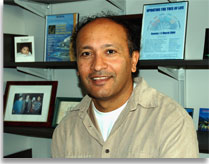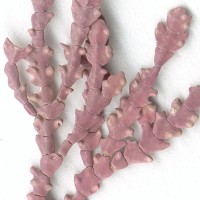
Debashish Bhattacharya
For Debashish Bhattacharya, the knowledge that half the
oxygen on Earth is generated by algae through photosynthesis begs an important
evolutionary question: How did algae come to be such industrious
carbon-dioxide-consuming, sugar-and-oxygen producing factories? Did
each of the two major kinds of algae, red and green, evolve their
photosynthetic abilities separately? Or did they have a common ancestor?
Red algae are mostly aquatic and include such familiar
organisms as sushi wrap and are the sources of agar and
carrageenan. Green algae are terrestrial, and are genetically related to all land plants.
Thanks to the recent research of Bhattacharya and his
co-authors, published in the journal Current
Biology, it appears likely that red and green algae do have a common
ancestor, since they share about half the genes in their their genomes. Scientists had long
thought this must be so, but had little evidence to back up their hunch,
because red algae genomes are usually very large, and their sequencing was such
a long, involved, expensive process.
In fact, scientists since Darwin’s time have hoped to construct a great
genealogy, or “tree of life,” which could describe the interrelationships of all
living things on the planet. Bhattacharya and his co-authors undertook to unite
a key limb of that “tree,” the limb that includes all red algae, green algae
and land plants.
“What we knew about red algae we learned from sequencing
extemophiles – algae that live in extreme environments – because their genomes
are relatively small,” said Bhattacharya a professor of ecology, evolution, and
natural resources in Rutgers’ School
of Environmental and
Biological Sciences. “But most red algae are mesophiles, which means they live
in relati

Red algae,
Calliarthron tuberculosum
vely normal temperatures.”
But recently, a new generation of gene sequencing machines
has become available, and Bhattacharya’s lab has acquired one. This machine
allowed him and his co-authors to sequence the entire genome of
Calliarthron tuberculosum and a comprehensive list of expressed genes
- genes caught in the act of fulfilling their functions - for
Porphyridium cruentum, two species of red algae, in just a couple of weeks. They
were then able to compare this bonanza of data to all the data available in
protein banks, discovering that red and green algae shared half their genomes –
and that red algae also shared a considerable part of its genome with other,
non-algae organisms.
“The availability of next-generation sequencers has opened
the window to generate sequences from all kinds of organisms,” Bhattacharya
said. “This has opened our eyes to how complicated the history of genes is in
the tree of life. Here, we finally got genomic data for normal red algae, and
that’s opened our eyes to, holy smoke, how complicated they are.”
Bhattacharya believes the research has important practical
implications. “The ancestor gave rise to the algae that generated all the fuel
we currently use in cars and planes, and the photosynthetic organelle they
contain is the target for modern biofuel research using fast-growing algae.”
Knowing what red and green algae will help scientists to
figure out how they differ, and how those differences may be manipulated to
create better algae for biofuel research, according to Bhattacharya. “For
example, these algae could be designed to incorporate desirable characteristics
from both lineages,” he said.
Bhattacharya’s co-authors are Titas Banerjee, a Rutgers
undergraduate at the time she took part in the work; postdoctoral scholar
Cheong Xin Chan; Hwan Su Yoon, of the Bigelow Laboratory for Ocean Sciences in
Boothbay Harbor, Me.; Patrick Martone, of the University of British Columbia;
and Jose Estevez, of the University of Buenos Aires.
Media Contact: Ken Branson
732-932-7084, ext. 633
E-mail: kbranson@ur.rutgers.edu


